Marketing was always a local business venture until digital marketing emerged as a key method of selling your products. Nowadays, globalization and internet penetration have enabled businesses to promote or sell their products worldwide. Open an online store and there you go! the entire world is your next potential buyer. But digital marketing for international business is not that simple. It involves creating an effective plan of action and effective cross-border digital marketing strategies to get your business rolling. Digital marketing has grown immensely in recent years. According to stats, Advertisement spending in digital marketing is projected to reach $740.3 billion worldwide in 2024.
In this article, we’ll discuss some essential tips that will put your business on the path of higher profitability and sales in the international market. The process starts with familiarizing yourself with your global audience and creating a foolproof SEO and email strategy that brings more eyeballs to your business. Since we are going global, it is important to generate multilingual content to effectively get across your brand’s message. Social media and influencers play a big role in creating hype, so you can’t forget about them. Running PPC ad campaigns is a vital step in getting your business mainstream. However, make sure you are adhering to the different regulatory requirements and policies. Moreover, Adapting your business according to the changing market trends makes all the difference. Lastly, if you don’t have a finish line in mind, you’ll get nowhere. Therefore keep track of your ROI and success to get better future insights.
1. Understanding Your International Audience
If you are unaware of the likings, preferences, and buying patterns of your target customers, your business can’t excel in the international market. Identifying target demographics in various regions after in-depth research and keeping cultural nuances in mind is important in this aspect.
Researching and identifying target demographics in different regions
One important factor required to maximize the chances of your international success is thorough research of your target audience. For this purpose, it is important to understand local traditions, customs, preferences, and market trends. Whatever products or services you are putting out on the internet, make sure they align with the respective cultural norms and customs. This is to ensure your brand stays on the same wavelength and frequency as your local consumers.
Cultural considerations and localization of content
Localization means adapting a product or service according to a specific country’s standards or local market trends. It is not just about language translation, there are a lot of factors involved. You have to tailor your brand’s messaging, product packaging, and promotional materials according to the cultural values of a specific region. Your brand will be respected and well-received by local consumers if you consider their cultural nuances. Not only this, it can also foster a positive brand reputation among the international audience.
2. Global SEO Strategies
Search engine optimization or SEO is responsible for your brand’s visibility on search engines. The significance of SEO can be highlighted by the fact that 53% of all website traffic directly comes from organic searches. Therefore, your business digital address (Website) must be properly optimized by Global SEO Strategies to its core. Let’s go through some top SEO strategies that can bring you organic traffic.

Conducting keyword research for different languages and regions
Digital marketing for international businesses involves making your brand relevant and the search engine’s favorite in different languages and regions. Optimizing your business only in your home country won’t be enough. You must optimize your website in every target market you aim to establish your brand’s worth and value. To identify the most relevant search terms, conduct keyword research in multiple languages. Integrate these keywords into your meta tags, website content, and other digital platforms. Doing so will boost your online visibility and attract organic traffic from different global audiences.
Optimizing website content for international SEO
Optimizing website content for an international audience requires a holistic approach, focusing on both technical SEO and cultural relevance. To make your website content globally appealing, Identify keywords in each target language, considering local search behaviors and preferences. Use tools like Google Keyword Planner, Ahrefs, or SEMrush to find popular search terms in various regions and demographics.
Utilizing hreflang tags and geo-targeting
Using Hreflang HTML tags and geo-targeting helps to communicate and navigate your website’s regional variations and language to search engines. Using these SEO identifiers helps different search engines deliver the most appropriate site version to your audience or users.
Importance of local backlinks and citations
Local backlinks and citations boost local SEO by increasing your website’s relevance, credibility, and visibility. Search rankings are improved by backlinks from local sources. Accurate citations across directories ensure easy verification of your business information. Together, they strengthen your local online presence and attract more customers.
SEO is vital for going big in the international market. If you are a business struggling to top the search results page, then look no further! Cretesol Tech is offering SEO services that will increase your website’s online visibility and organic traffic.
3. Creating Multilingual Content
Apart from incorporating relevant keywords in the content of your website, creating a website that is suitable for an international audience is also crucial. One way to make your website more internationally friendly is by making it multilingual. A website that is multilingual increases engagement and accessibility for diverse audiences that speak different languages.
Importance of translating and localizing content
Imagine a foreign language speaker coming to your website, if he or she can find the relevant cultural keywords and his native language on that site, your website’s engagement and traffic are bound to skyrocket. In addition, localized content and translated websites improve user experience which ultimately improves your SEO rankings in various regions.
Best practices for multilingual website structure
As mentioned before, using hreflangs and geo-targeting is one practice of making your site multilingual. Other than that, clear URL formats like subdirectories or subdomains can also make a positive impact. Lastly, Improve technical SEO by optimizing site speed and ensuring mobile compatibility, which ultimately improves regional performances.
Tools and services for effective translation
There are several tools and services available that can effectively translate and localize any website. Some of the prominent ones are,
- SDL
- MemoQ
- SmartCAT
- Trados Studio
4. International Social Media Strategies
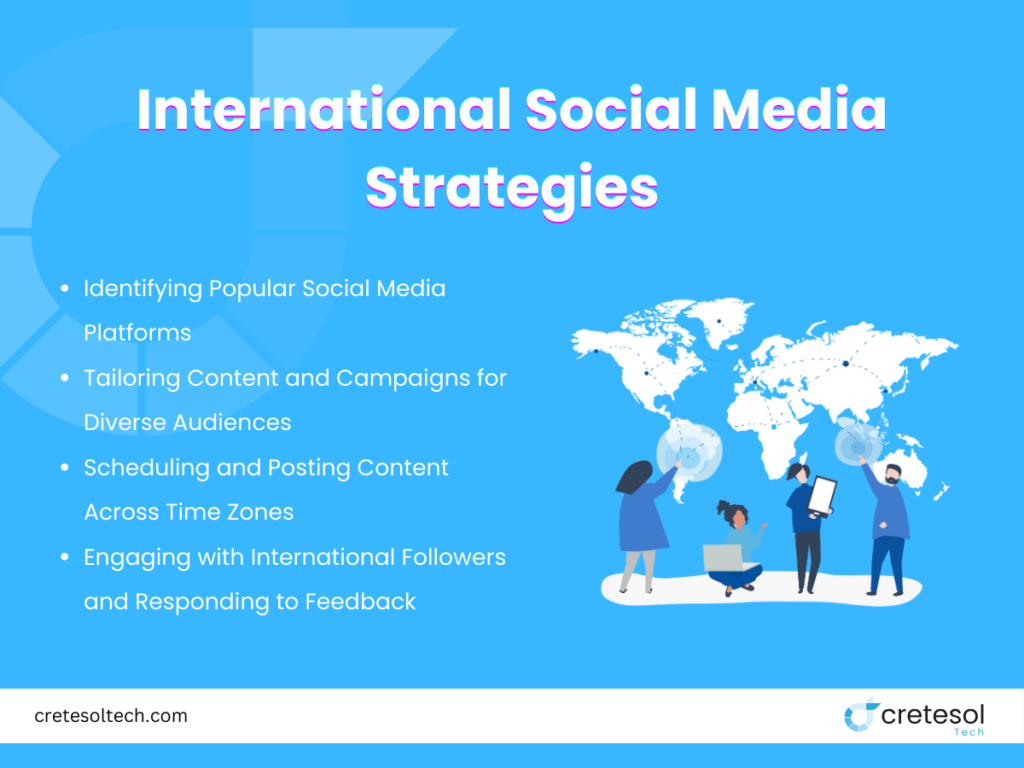
Social media has become an indispensable tool for businesses seeking to expand their global reach. With over 5 billion active social media users worldwide, companies can no longer afford to ignore the vast potential of social media.
Identifying popular social media platforms
Before crafting International Social Media Strategies, it’s essential to understand the diverse social media landscape. Here are the biggest social media platforms and their number of active users worldwide as of April 2024:
| Platform | Number of Active Users |
| 3.065 Billion | |
| YouTube | 2.49 Billion |
| 2 Billion | |
| 2 Billion |
Tailoring content and campaigns for diverse audiences
Social media has massive potential to bring heavy profits and ROI for your business when used the right way. Digital marketing for international businesses can’t be done effectively unless you are utilizing the true potential of social media. In order to get maximum following and interactions on social media, it is important that you develop social media content in accordance with the diverse audience. Personalize your content by keeping in mind the cultural differences and intricacies to get more engagement from your target audience.
Scheduling and posting content across time zones
You don’t want to post on social media at a time when everyone is inactive or sleeping. Therefore, making a proper schedule for your social media posting is extremely vital. Keep track of the time zones of different continents to find the perfect time for posting. It is suggested to post at a time when most people are active on social media platforms.
Engaging with international followers and responding to feedback
A business that regularly interacts with its customers develops a good brand image. You can achieve this on social media by engaging with your followers in the comment section or by providing them with prompt feedback. This instills a sense of trustworthiness and credibility among your target audience and your chances of achieving success in the global market become much more bright.
5. Leveraging Influencers and Partnerships
Identifying and collaborating with local influencers
Partner with local influencers who understand the regional market and can promote your brand authentically. Influencers have built trust with their followers, and their endorsement can significantly enhance your brand’s credibility and reach within specific markets.
Building partnerships with international brands and businesses
Partnering up with other businesses in your niche is a crucial strategy for effective digital marketing for international business. Working with well-established brands in target markets, startups can leverage their expertise, resources, and audience reach to maximize their international presence and experience. These partnerships promote cross-promotion, co-branding opportunities, and entry to new markets. The bottom line is, that it drives growth and expands the digital footprint of the business on a greater level.
6. International PPC Advertising
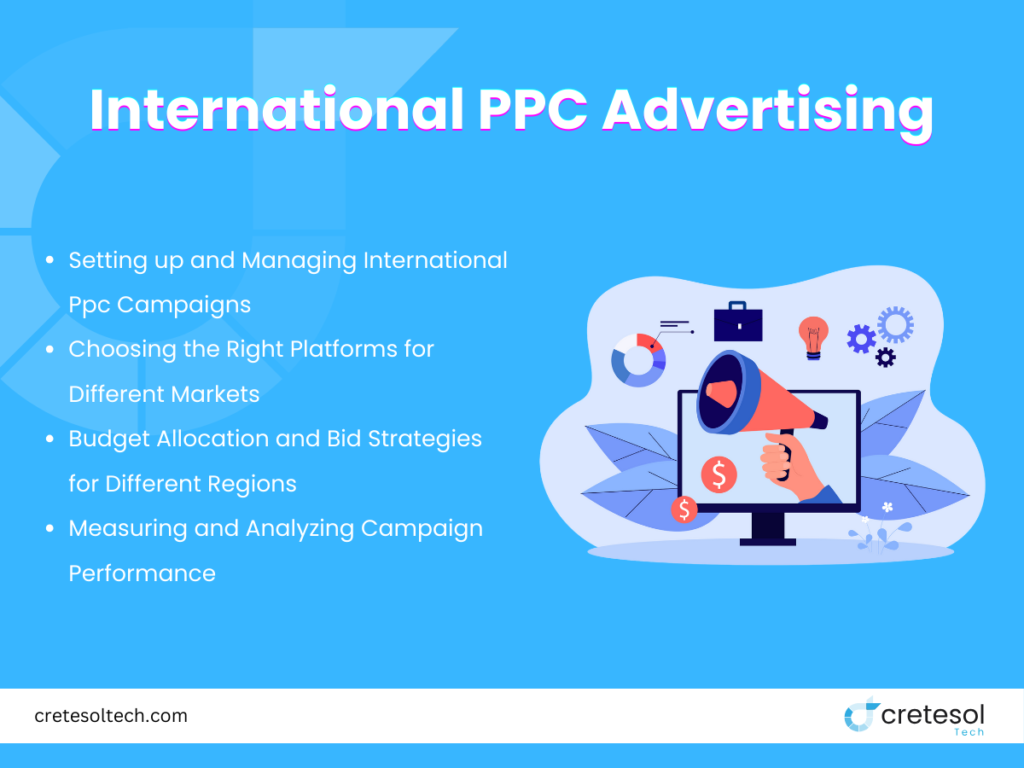
One of the benefits of international PPC advertising is that it extends the reach of PPC marketing to global audiences. Let me talk about the components of a successful international PPC campaign.
Setting up and managing international PPC campaigns
Setting up Pay-per-click campaigns is a process that needs careful attention to make the entire marketing funnel run smoothly. Personalize your every campaign according to your target market or audience for maximum return. For this purpose, customize your PPC campaigns according to cultural preferences, behaviors, attitudes, and languages.
Choosing the right platforms for different markets
Although Google Ads is widely used pretty much everywhere bar a few countries, it is important to select the right platform for different markets. Identifying region-specific platforms and then doubling down on their audience can revolutionize your business. For instance, Google Ads for global reach, Baidu for China, and Yandex for Russia.
Budget allocation and bid strategies for different regions
You don’t want to be dumbfounded by allocating the same amount of budget for every market do you? Therefore, first, observe and study the potential and competition each market has to offer and afterward decide the budget accordingly. Moreover, adjust your bid strategies to optimize ROI in each region.
Measuring and analyzing campaign performance
The absence of data can lead to massive blunders. Therefore, the use of analytics tools to monitor performance is really vital. Furthermore, track conversions, and refine campaigns based on data insights to ensure effectiveness across different markets.
7. International Email Marketing Strategies
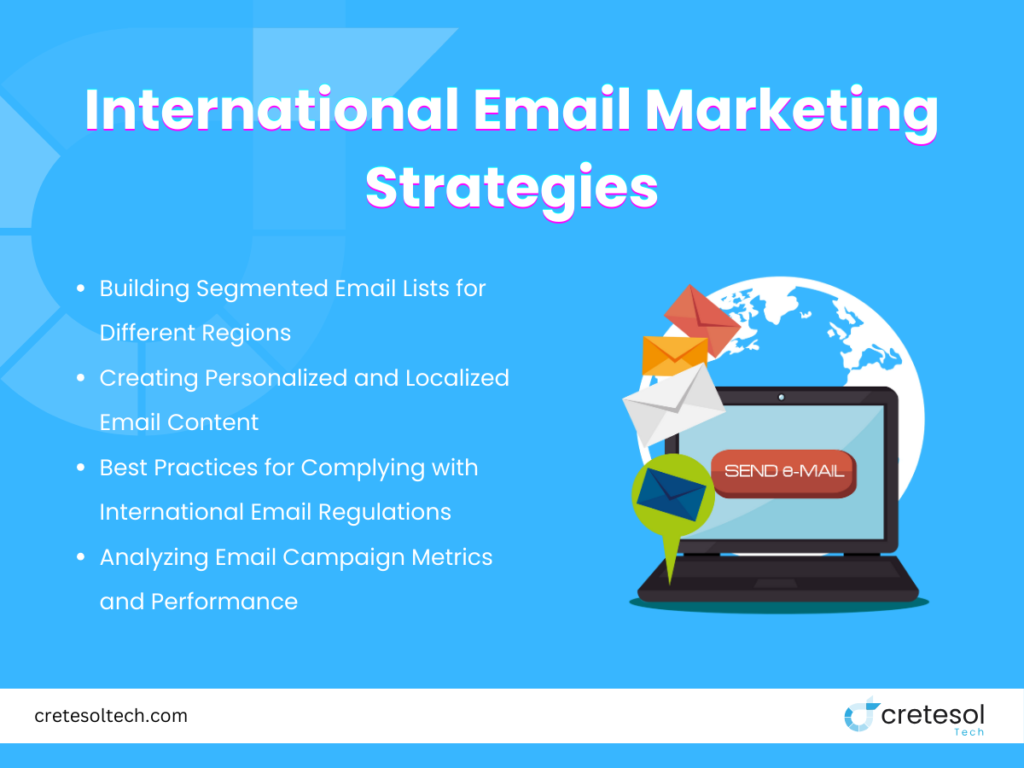
Building segmented email lists for different regions
Segment email lists by region to ensure messages are relevant to each audience, a key tactic in effective International Email Marketing Strategies. Having a segmented email list eases off the burden and you can conveniently drive your email marketing campaigns without hitting any significant roadblock.
Creating personalized and localized email content
Each culture has its own slang words, writing style, and audience behavior. Your email content should not feel alien to the local audience. It should be just as if their local restaurant is reaching out to them for a Christmas discount. A homely feeling instigated by localized email content can drive increased leads and conversions.
Best practices for complying with international email regulations
Adhere to international email regulations, such as GDPR and CAN-SPAM, to maintain compliance and build trust with global audiences. In addition, following these regulations can result in a positive brand image and reputation.
Analyzing email campaign metrics and performance
Regularly measure and analyze campaign metrics to refine strategies, ensuring optimal performance and alignment with overall digital marketing for international business goals.
8. Adapting to Different Legal and Regulatory Requirements
Understanding international data privacy laws and regulations
Familiarize yourself with data privacy laws such as GDPR, CCPA, and others to ensure compliance in digital marketing for international business. This will keep your business out of trouble and help you to focus solely on your business progress.
Adapting marketing strategies to comply with local laws
Modify digital marketing tactics for international audiences to meet local legal requirements, ensuring lawful and effective campaigns. Make sure to do a proper analysis of their law before attempting to initiate any campaign to stay out of troubled waters.
Resources for staying updated on international regulations
Utilize resources like legal advisories, industry blogs, and governmental websites to keep abreast of changes in regulations affecting digital marketing in global markets.
By adhering to these practices, businesses can navigate cross-border digital marketing challenges and effectively reach international audiences while remaining compliant.
9. Analyzing and Adapting to Market Trends
Monitoring and analyzing market trends in different regions
Regularly track regional market trends to stay informed about consumer behavior, preferences, and emerging opportunities crucial for digital marketing for international business. In this ultra-fast world, trends keep on changing. Deploying an obsolete marketing strategy will be a recipe for disaster for your business.
Adapting marketing strategies based on market insights
Use insights from market analysis to tailor digital marketing for international business strategies, ensuring they align with local trends and maximize engagement. Market insights can help your business make a huge jump in your niche and generate extraordinary revenue in a short time.
Tools for tracking international market trends
Leverage tools such as Google Analytics, SEMrush, and local market research reports to gather data and refine digital marketing for international business efforts. This ensures your hard work doesn’t go to waste and your efforts are data-driven and effective.
10. Measuring Success and ROI
Setting clear goals and KPIs for international marketing campaigns
Define specific goals and key performance indicators (KPIs) to evaluate the success of your digital marketing for international business initiatives.
Tools and techniques for tracking performance across different markets
Utilize helpful tools like Google Analytics, HubSpot, and regional analytics platforms to monitor and compare the performance of digital marketing for international business campaigns in various markets.
Analyzing data to measure ROI and identify areas for improvement
Regularly analyze collected data to measure return on investment (ROI) and pinpoint areas where digital marketing for international business strategies can be refined and optimized for better results.
Conclusion
The tips we’ve shared can seriously amp up your digital marketing game for international business when you nail the timing and placement. To crush it in digital marketing for international business, start by really getting to know your global audience and developing killer SEO and email strategies. Craft multilingual content to get your brand’s message across effectively, and harness the power of social media and influencers to create some serious buzz. Launch PPC campaigns to gain traction, but don’t forget to stick to the local rules and regulations. Stay flexible by adapting to market trends, and always keep tabs on your ROI to keep improving your strategies. Follow these tips, and you’ll set your business up for major profitability and sales on the international stage!
If you are also a business struggling to get going, Cretesol Tech can turn your fortune by applying proven digital marketing strategies that are highly rewarding and profitable.
FAQs
How does digital marketing help in international business?
Digital marketing helps international businesses by increasing global visibility, reaching diverse audiences, and driving sales through targeted online strategies like SEO, social media, and PPC campaigns.
What is digital and international marketing?
Digital marketing uses online channels to promote products or services, while international marketing adapts these strategies to different countries and cultures to engage a global audience.
How to develop an international digital marketing strategy?
Develop an international digital marketing strategy by understanding target markets, creating localized content, utilizing appropriate platforms, complying with local regulations, and continuously analyzing performance metrics.
How do I market my business internationally?
Market your business internationally by conducting market research, localizing your website and content, leveraging social media, using targeted PPC campaigns, and building partnerships with local influencers.
What are the 10 steps of international marketing?
- Conduct market research
- Identify target markets
- Develop a marketing plan
- Adapt products/services
- Localize content
- Choose the right platforms
- Implement SEO strategies
- Run PPC campaigns
- Build local partnerships
- Measure and analyze results
How do you attract international markets?
Attract international markets by offering localized content, using targeted digital marketing strategies, engaging with local influencers, and ensuring your website and customer support cater to different languages and cultures.
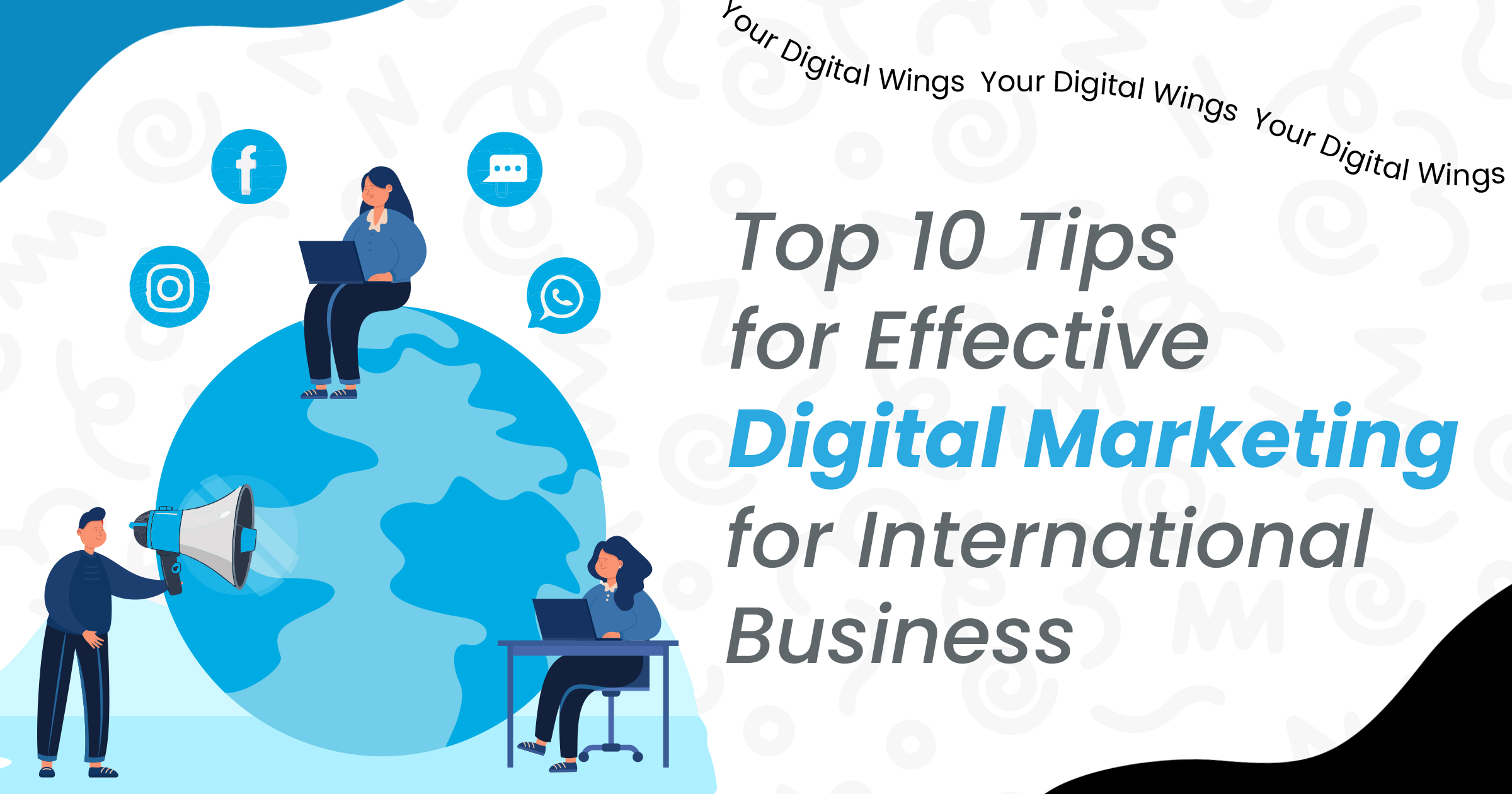
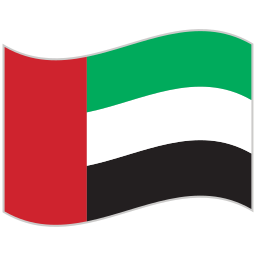 United Arab Emirates
United Arab Emirates